Article updated 23.1.2023
Microsoft Project for the web takes project management to the next level by connecting to Teams and other Microsoft 365 cloud services and offering functionalities such as roadmaps, task dependencies, and different visual views.
Project management became a lot easier with Microsoft’s release of the new Project, or Project for the Web (PftW), as part of its cloud services portfolio in 2019. Since then, Microsoft has continuously developed the Project for the Web environment to make it even more diverse, listening to user expectations and wishes.
Since the Planner became available on Teams, work groups and project teams have taken advantage of its simple and easy-to-use functions for a variety of uses.
Of course, even Planner goes a long way when the need for project management is a light, informal activity with the start and end dates. You can define tags, priority classifications, and a task container for tasks to describe, for example, the amount of workload. The progress of a task or project can be monitored with the indicator “not started – in progress – completed” and, for example, with a checklist of work-related tasks.
You can attach several people in charge of the task or project, a description, and notes and attachments. You can also add comments, so it is easy and convenient to discuss a task or part of a project directly in Planner.
Planner thus offers the simplest functionalities for project management. As needs grow beyond the basic features offered by Planner, Project for the web offers more diverse options for the slightly more challenging project management needs.
I recommend trying the very easy-to-use Project for the web, which makes it easier to manage both the project entity and its interdependent tasks. Project for the web is a tool for those project managers and team members who do not necessarily need to use heavy project management methods such as PRINCE2 and PMP (Project Management Professional).
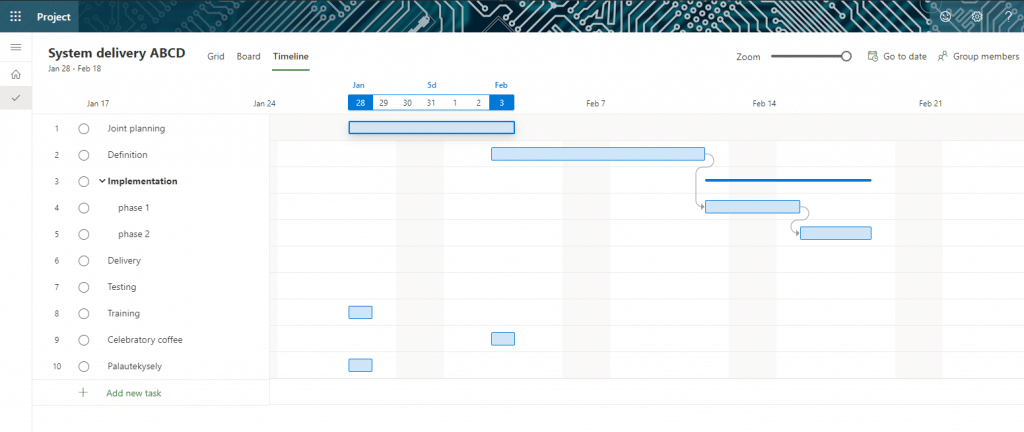
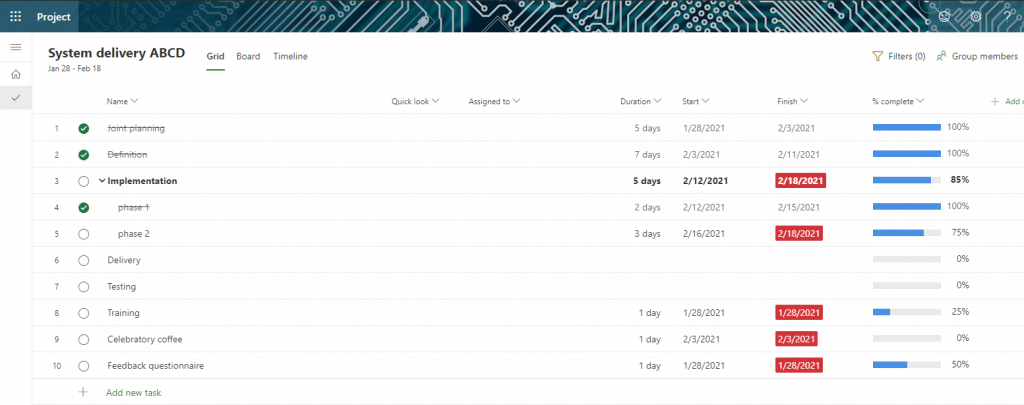
Microsoft Project for the web makes project management easier
Microsoft Project for the web is a very practical tool for project management that is easy and quick to learn to use. The functionalities of the application offer versatile opportunities for more comprehensive project management in the roles of both project managers and project members.
Below is a summary of the features and functionalities of Planner, Project for the web, and the Project Online web and desktop applications:
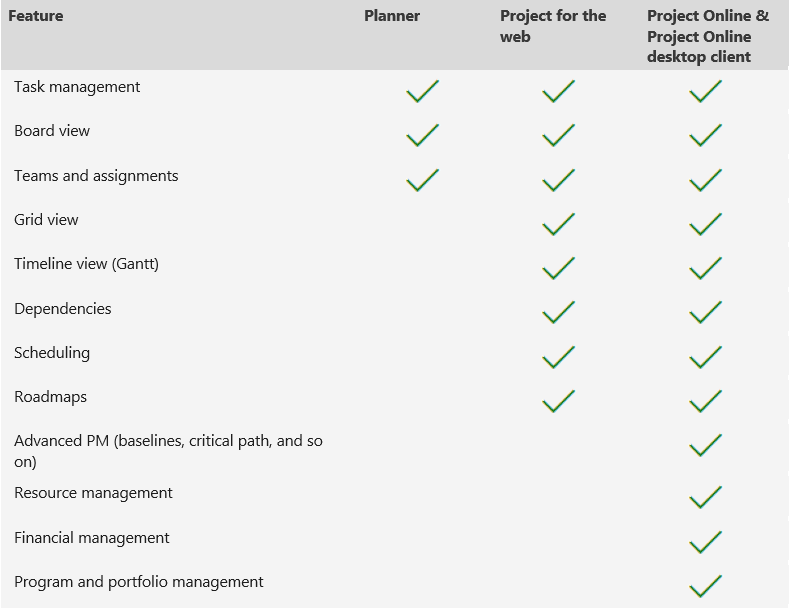
Project for the web visualizes key information for project management
Visual views are definitely the strength of Project for the web, which makes it easy and fast to us the application and process the information PftW presents. Project for the web therefore provides a comprehensive list of different views as well as graphical and other indicators to facilitate project management:
- With the visual whiteboard view, you can improve the tracking of work tasks and project progress by using ready-made and customizable task boards.
- Dependencies between tasks can also be monitored visually.
- The grid view is used for the hierarchical management of tasks in project planning.
- Visual and interactive milestones help track projects and tasks.
- Project Home view allows you to have a helicopter perspective on projects you have been working on recently. Projects of important priority can also be displayed there.
- Task scheduling helps to create an accurate schedule for project deadlines using start and end dates, workload, and dependencies.
- A hierarchical timeline view displayed per the Gantt chart helps to visually view and understand project deadlines, tasks, and the dependencies between them.
- Summary tasks help plan, manage and track project deliveries and phases.
- Roadmaps as a summary portfolio view help to form an idea of the progress of strategic and other projects.
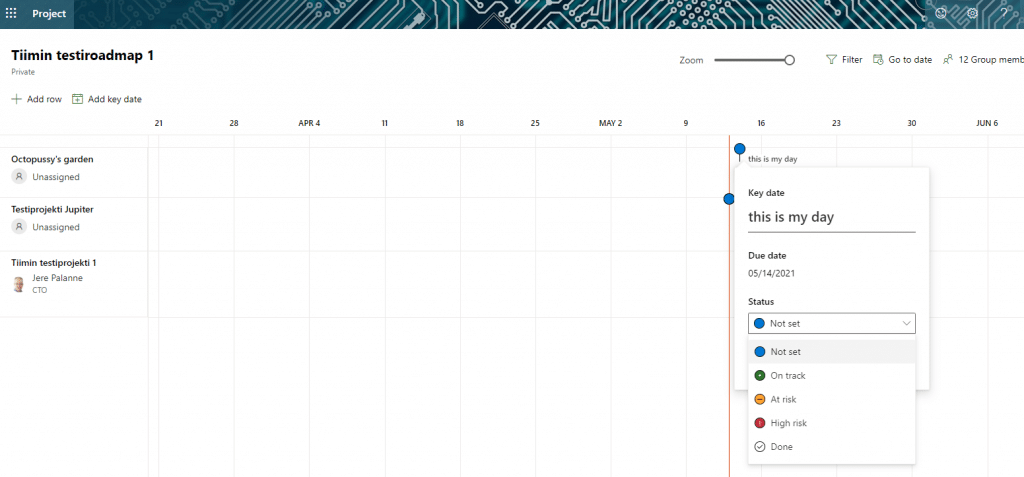
Project management as part of Microsoft 365 services
Project for the web is built on the Power Platform, so the implementation of custom applications is convenient. For example, a mobile application can be developed with Power Apps utilizing Project for the web data stored in a common data model database in Microsoft Data. In addition, reporting can be implemented with PowerBI and automatic workflows can be created with Power Automate.
Combining Project for the web with other Microsoft cloud services such as Teams offers a variety of opportunities to leverage the features of different tools in project work. PftW’s integration into the ecosystem of Microsoft 365 cloud services and Office 365 groups makes managing information and documents much easier when integrated into Teams.
There are many opportunities to improve the efficiency of project management and the use of Teams, such as:
- Easily and quickly create team-specific projects and roadmaps in Teams
- Add Project for the web as apps to the Teams group tab
- Creating templates for Teams channels, folder structures and documents according to the stages of the project at the start of the project
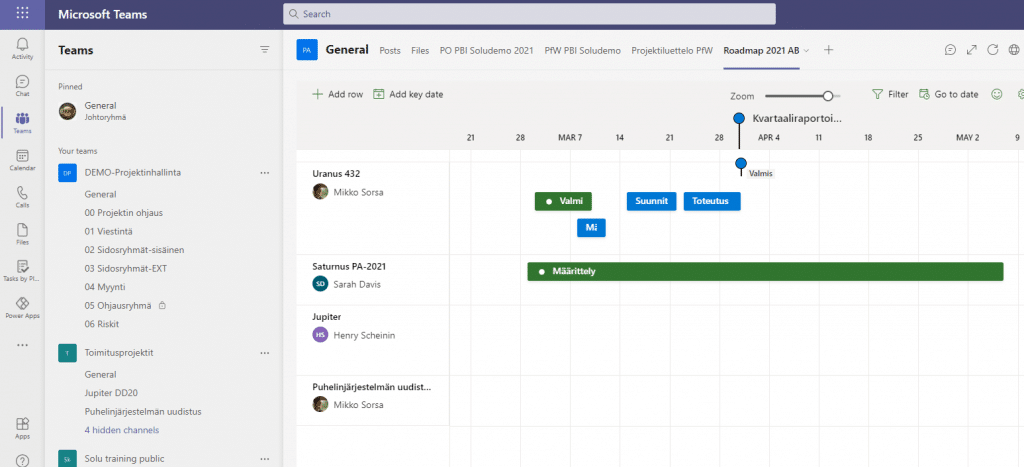
Microsoft Project for the web: pros and cons to consider
Project for the web offers many features and functionalities for use in your own and your organization’s project work, in addition to Teams integration and the Microsoft 365 cloud services ecosystem, such as:
+ Web browser-based interface for working independently of time, place, and device.
+ Visual views, especially the timeline view and interdependencies between tasks, help to understand and manage the project entity.
+ Co-editing allows you to edit and update to-do lists and project schedules simultaneously between multiple project team members and other stakeholders.
However, there are a few things to keep in mind when considering using Project for the web:
– Project for the Web user licenses include access to the PowerApps project list. If there is a need to integrate project environment information into other systems, you may want to review the license requirements for, for example, Power Apps, Power Automate, and Power BI licenses.
– Users outside the organization do not yet have access to Project for the web’s projects and tasks.
Time is saved when information and tools that are important for project management can be conveniently found in connection with other Microsoft 365 programs and in a familiar operating environment.
For example, with the help of Teams and Power Platform, project management solutions can be customized to your own needs if the organization has not defined and instructed users on unified operating methods related to the use of project management methods and tools.
Find out more about our customer stories:
- The city of Turku & Solu Digital: Project work independent of location and device with the help of automation
- HSL & Solu Digital: Tools for transparent project culture and methodology
- HSY & Solu Digital: Managing projects and contracts using Investment Window
- Construction company Lapti Oy & Solu Digital: Managing the clientele and customer projects
Read more about solutions for project management:
- Manage projects with the right practices and applications
- Microsoft Project for the Web: Project List and Project Form
- Microsoft Project for the Web: reporting with Power BI
- Solu 365® automates project management
- Manage projects with the OKR model and Viva Goals
Please contact me or my colleagues in case you have questions about solutions for project management!
Mikko Sorsa
Senior Consultant, Partner
Download the project management guide
Download our guide to smooth project management and make your organization's project work easier. Leave your contact information and we will send the guide to your email.








